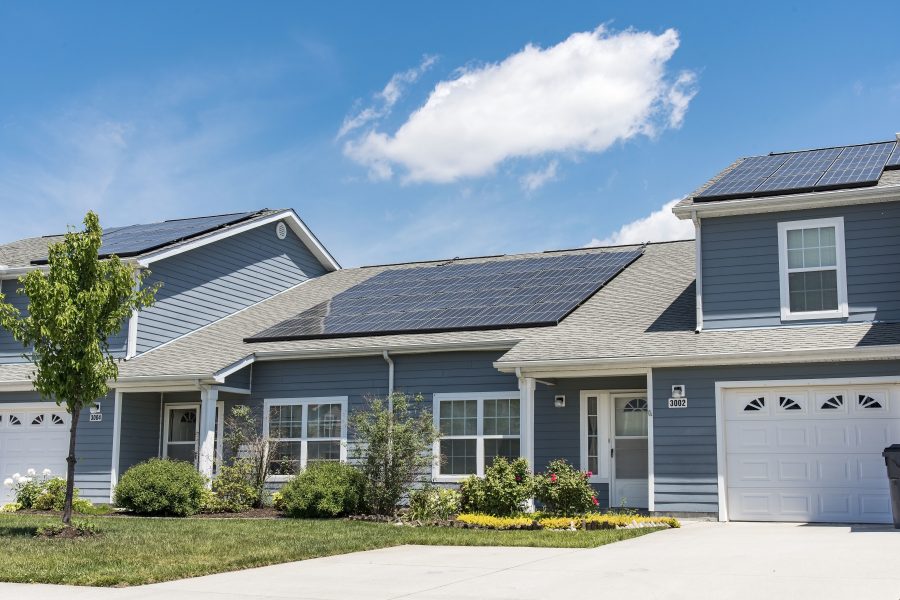The Air Force is finalizing measures meant to help its families as it nears a May 1 goal for putting the Pentagon’s new Tenant Bill of Rights into full effect.
Military officials had more work to do to implement tenant protections even as they signed the Bill of Rights in late February. Last month, the service issued an updated, 252-page guidance document that is now the governing policy for Air Force family housing.
The Tenant Bill of Rights aims to protect military families from private landlords that poorly manage base housing, leading to problems ranging from mold to rodents to safety code violations.
“Move-in checklists were developed in March and are being further refined to adjust to additional requirements implemented under the Tenant Bill of Rights and requirements spelled out in the 2020 [National Defense Authorization Act],” the Air Force said in written answers provided April 22.
Privatized military housing residents will now receive a briefing on their rights and responsibilities as tenants when they move into a new home. Air Force military housing offices are sharing the Tenant Bill of Rights with residents as part of that move-in briefing, and sending it out to people who already live in privatized units.
“Air Force housing officials are ensuring each installation’s briefing template meets the unique requirements of each base’s housing project, such as specified maintenance request and completion times as identified in the project’s ground lease documents,” the service said.
Tenant protections also include reforms to how companies are paid for their management. Earlier this month, the Air Force announced that the Corvias Group was its first landlord to reach a new agreement with the service on how they will be judged on and awarded bonus pay for good performance. Corvias oversees about 3,900 housing units at six USAF installations.
“The commander evaluation will make up one-fourth the total award of the new incentive plan and focuses on resident satisfaction, project safety, maintenance management, and financial management,” the Air Force said April 14. “Resident responses via work order satisfaction surveys and the annual resident satisfaction survey will inform evaluation if project owners are meeting the tougher metrics spelled out in the revised plan.”
Nine other Air Force landlords of 26 housing projects will renegotiate their own performance incentive fee plans, which have been exploited for profit. Reuters and CBS News reported last year that Balfour Beatty Communities earned millions of dollars after faking home improvement records.
USAF is hiring resident advocates as part of a push to expand military housing office staffs, after an April 2019 Air Force Inspector General report said less than half of residents interviewed had resolved complaints through the housing offices, and many people did not know those offices exist. Resident advocates can help ensure that a landlord company doesn’t ignore complaints or lie about work being done.
They are aided by the survey tool Satisfacts, which is used at all but six USAF privatized housing sites. Installations that have an “alternative process to record resident satisfaction of work orders” are: Joint Base Elmendorf-Richardson, Alaska, Joint Base McGuire-Dix-Lakehurst, N.J., Dover Air Force Base, Del., MacDill Air Force Base, Fla., Wright-Patterson Air Force Base, Ohio, and Offutt Air Force Base, Neb.
“The survey data reflects that residents are embracing the tool as a way to voice their opinion of the customer service they receive during maintenance work orders,” the Air Force said. “For each rating below 3.5 out of 5.0, the resident receives a call from their military housing office to learn more about their dissatisfaction in order to discover the root cause of the issue.”
A recent Government Accountability Office report criticized the military’s approaches to collecting satisfaction survey data, particularly the practice of counting a “neither agree nor disagree” response to a question as voting “yes.”
“For one Air Force installation, if officials had not counted responses in category 3 as ‘yes,’ the resident satisfaction rate for newly constructed units would have been more than 20 percent lower than what was reported,” the report said. “For one Air Force project, OSD reported identical resident satisfaction data for the fiscal year 2015, 2016, and 2017 reports, despite the fact that Air Force officials had noted … data were from the annual resident satisfaction survey conducted in December 2013.”
GAO also noted that the Air Force is moving to an inspection policy where installation commanders contact all privatized housing residents to offer in-person walk-throughs. That has varied by location so far.
“Military housing office officials at one Air Force installation told us that they inspect 100 percent of homes that have completed change-of-occupancy maintenance, while officials from a different Air Force installation stated they inspect 10 to 20 percent of these homes,” GAO wrote. Auditors visited Davis-Monthan Air Force Base, Ariz., Joint Base Langley-Eustis, Va., and Tinker Air Force Base, Okla.
Even as the services implement the bill of rights, the Pentagon is still trying to move forward with companies and lawmakers to add three other provisions: access to maintenance history, a dispute resolution process, and the ability to withhold rent payments until a dispute with a landlord is resolved.

